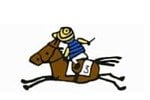-
 Three-year-olds and upwards. Six furlongs. First run 1840
Three-year-olds and upwards. Six furlongs. First run 1840
The first official staging of the Stewards’ Cup took place in 1840 but the name actually dates back to 1834 when the senior of the two stewards officiating at Goodwood awarded a cup worth about £100 to any race of his choosing.
The chosen race varied year on year, with the Cup being contested over distances ranging from six furlongs to a mile and a half. Lord George Bentinck conceived the idea of a competitive sprint handicap at the Goodwood Festival meeting, largely as a betting medium, in late 1839. So in 1840 the six-furlong Stewards’ Cup as it is now known was born.
Epirus, owned by John Bowes, from Co Durham, made the long journey from John Scott’s Malton yard in Yorkshire worthwhile as he won the 1840 race under the trainer’s brotherWilliam, who had a fondness for the bottle and was frequently so drunk that he was unfit to ride.
By 1849, the race already carried £300 of the total £860 added prize money at the meeting. The Stewards’ Cup still retains its position as one of the most prestigious and valuable handicaps of the season, not least due to substantial sponsorship.
The first German-bred winner of the Stewards' Cup (pre-dating a French-bred victory on English soil by three years) was Count Hahn's Turnus, who triumphed in 1850. He defied a penalty to add the Chesterfield Cup at the meeting two days later.
Sweetsauce won the Stewards' Cup at 20/1 in 1860 and just two days later was victorious in the Goodwood Cup over a stamina-sapping two miles and five furlongs.
The race gradually grew in stature and by 1879, horses of Peter’s calibre were lining up for the Stewards’ Cup. Peter had taken the previous year’s Middle Park Stakes at Newmarket and was well fancied for the Derby until his nomination was voided on the death of his owner General Peel. Sir John Astley acquired the quirky horse who also won Royal Ascot’s Royal Hunt Cup and the Hardwicke Stakes in 1881, but gained notoriety when refusing to race in the Goodwood Cup.
In 1883, the previous year’s Oaks heroine Geheimniss led the field approaching the winning post, only to be denied a head by Sir George Chetwynd’s Hornpipe who got up in the final stride to land amajor gamble. Another Classic winner was defeated in 1899 when Northern Farmer finished a neck in front of the 1898 1,000 Guineas winner Nun Nicer.
There have been three dual winners in the history of the Stewards' Cup. Marvel scored in 1890 and 1892, while Lord Annandale triumphed in 1913 and shared the spoils in a dead-heat the following year with Golden Sun. Sky Diver was victorious in successive years, 1967 and 1968.
The only dead-heat in Stewards’ Cup history occurred in 1914 as Europe prepared for all-out war. Golden Sun shared the spoils with Lord Annandale, who had won the race outright the previous year. The outbreak of the First World War saw the race transferred to Newmarket from 1915 to 1917 and not run at all in 1918. The Second World War also halted racing at Goodwood and the 1940 race was abandoned with the following year’s renewal also staged at Newmarket. Windsor hosted a version of the Stewards’ Cup from 1942 to 1945.
The post-war crowds flocked to Goodwood for the Stewards’ Cup of 1947, so much so that Sir Noel Murless, then training at Hambleton in Yorkshire, made the long journey south only to find his horsebox stuck in traffic on the narrow lanes at Singleton, just to the north of the course. Gwen Murless, the trainer’s quick-thinking wife, unloaded their big-race hope, Closeburn, and jogged him the two miles to the course just in time to saddle him for the Stewards’ Cup. The Murless charge, carrying a then record weight for a three-year-old of 8st 10lb, prevailed by a neck under Gordon Richards.
Twelve years later, Sir Winston Churchill was rewarded when Tudor Monarch carried his pink and chocolate colours to victory under a youthful Geoff Lewis.
Spillers was the first commercial sponsor of the Stewards' Cup from 1970, when Lester Piggott partnered Jukebox to victory, until 1980. The 1981 renewal was backed by the tote and then William Hill sponsored between 1982 and1992. Vodafone supported the race from 1993 right through to 2006, initially under the Vodac banner. Blue Square took over in 2007. The Stewards' Cup used to be run on the first day of Glorious Goodwood, the Tuesday, switching to the Saturday, the final day, under Vodafone's sponsorship in 1993.
In recent times, it is not unusual to see high-class sprinters winning the Stewards’ Cup. The brilliant filly Soba made all the running to take the 1982 renewal, one of her 11 victories that season, and returned to Goodwood to win the 1983 King George Stakes. Dandy (David) Nicholls partnered the flying filly and has since won the race three times as a trainer. The north Yorkshire handler saddled Tayseer to success in 2000, followed up with Gift Horse in 2005 and also primed 20–1 shot Evens And odds to score in 2010 under 5lb apprentice Billy Cray.
Richard Hughes’ victory on Tayseer meant he became the most successful current jockey in the bluesquare.comStewards’ Cup with three victories. The other two came on Shikari’s Son (1995) and Harmonic Way (1999).
The biggest winning margin since 1946 was in 1987 when the Peter Calver-trained Madraco won by four lengths. He was returned at 50/1, making him one of three horses since the Second World War to have triumphed at such mammoth odds. The other two were Ahonoora (1978) and Ashurst Wonder (1954).
Another top filly on the roll of honour is Lochsong, who in 1992 defeated 29 rivals at Goodwood and went on to land an unprecedented sprint handicap treble that also included the Portland Handicap at Doncaster and Ayr Gold Cup. She progressed to win the Group One Nunthorpe Stakes at York and was twice victorious in Longchamp’s Prix de l’Abbaye as well as coming back to Goodwood and winning two King George Stakes.
Coastal Bluff, the 1996 Stewards’ Cup scorer, was a second winner in three years for Thirsk-based trainer David Barron and jockey Jimmy Fortune, following For The Present’s success two years earlier. Coastal Bluff, like Lochsong, went on to win the Ayr Gold Cup and deadheated for first place in the following year’s Nunthorpe Stakes.
Michael Tabor netted over £200,000 when Danetime carried his colours and his money to victory as the 5/1 favourite in 1997. The victory, a first Stewards’ Cup triumph for Pat Eddery, was described by trainer Neville Callaghan as the highlight of his career.
Danetime subsequently stood at Coolmore Stud in Ireland as did the 1978 victor, Ahonoora, who sired the 1992 Derby winner Dr Devious. Danetime carried a huge weight of public money to victory but his odds of 5/1 were not as low as the 4/1 about the 2003 winner Patavellian. Roger Charlton’s charge was the shortest-priced favourite in the race’s history and proved his class with success in the Group One Prix de l’Abbaye on his next start.
The 1998 Stewards’ Cup saw the launch of the tote trifecta bet. The 1998 and 1999 runnings showed that horses can win from either side of the course, with Superior Premium successful on the far side and Harmonic Way racing down the stands’ side to victory.
Trainers and owners have been able to choose their horse’s stall position for the race since 1999 in a draw ceremony conducted two days beforehand at the racecourse. Yorkshire trainer, Tim Easterby, was successful in 2001 with Guinea Hunter, who got the better of Halmahera by a neck in a thrilling finish. After just witnessing their charge prevail, the connections of Guinea Hunter had the agony of a stewards' enquiry to endure but the placings remained unaltered.
Zidane may have been drawn in the stall no-one wanted but that did not stop James Fanshawe's charge lifting the 2007 bluesquare.com Stewards' Cup by a short-head in a last-gasp swoop. The five-year-old had been the long time ante-post favourite for the six-furlong sprint until the failure of connections to attend Thursday night's draw saw him allotted the unwanted 11 stall, and a drift in the market ensued.
Faith in the five-year-old returned in the build-up to the race and he was sent off the 6/1 favourite. Punters were rewarded as Jamie Spencer brought Zidane with a storming late charge to deny the previous year's winner Borderlescott in the final stride of a breath-taking contest.
William Haggas saddled the first two home in the 2008 bluesquare.com Stewards’ Cup, when 40/1 chance Conquest and Dane O'Neill just held off the fast-finishing 12/1 shot King’s Apostle by a head. The last trainer to have the one-two in the six-furlong handicap was Richard Hannon, whose Knight Of Mercy and Bocas Rose were separated by a neck in 1990.
Since starting stalls were first used in 1966, the luckiest draw has been stall 11 with five winners coming from that position. Four winners have been drawn in 19. No winner has come from stalls 2, 3, 4, 7, 13, 17, 23, 24 and 26. The numbering of stalls was changed in 2011 for right-handed courses like Goodwood and means it is the opposite to before. Low numbers used to be on the right looking from the stands and now are on the left.
Borderlescott was a popular winner in 2006 for Yorkshire trainer Robin Bastiman. The tough gelding was agonisingly pipped on the line by Zidane as he went for a Stewards’ Cup double 12 months later and gallantly carried top-weight to finish third behind 40/1 shot Conquest in 2008. Borderlescott gained handsome compensation when twice winning the Group One Nunthorpe Stakes at York (2008 & 2009) and taking the 2010 King George Stakes at Goodwood.
Roger Charlton, Dandy Nicholls and Fred Armstrong are the joint most successful post-war trainers. Charlton
saddled his third winner in 2009 when Genki followed on from Patavellian (2003) and Harmonic Way (1999).
Since 1946, the winning margin has been a short-head on 10 occasions, a head eight times and a neck 13 times. Before 2011 King’s Signet (1993) and Petong (1984) carried the highest weight to victory – 9st 10lb. That all changed last year when the Mick Easterby-trained Hoof It defied top-weight of 10st. The 13/2 joint-favourite was drawn in berth 18 of the 27 runners but was brilliantly ridden by Kieren Fallon to storm down the far rail for an impressive two and a half-length success.
Easterby, along with fellow part-owners, golfer Lee Westwood and agent Chubby Chandler, were narrowly denied Group One glory later in October, 2011, when Hoof It went down by a nose and a head in the Betfred Sprint Cup at Haydock Park.
At the other end of the weight scale, the three-year-old Psalmsinger carried a featherweight 5st 4lb when triumphant in 1845. The minimum weight is now 7st 12lb.
The bluesquare.com Stewards’ Cup has a maximum limit of 28 runners these days but that has not always been the case and in 1861 Croagh Patrick defeated 44 rivals to take the famous sprint. Only 12 lined up in 1842 when Lady Adela took the spoils and that is the smallest field in the race's history.
Epirus was a six-year-old when winning in 1840 and 11 other winners have been that age. Four-year-olds have been most successful with 67 wins, while three-year-olds have taken the prize on 51 occasions. The John White-trained eight-year-old Shikari’s Son became the oldest winner in 1995, taking the distinction from Epaulet, who was seven when triumphant in 1958.
Dermot Weld saddled Red Alert to success in 1974, the only Irish-trained winner of the Stewards’ Cup since 1946, while just 13 of the 66 favourites in that time have succeeded.
The £30,000 consolation race, the bluesquare.com Stewards’ Sprint Handicap for those horses who do not get into the Blue Square Stewards’ Cup, moved from Friday to become the first race on Saturday in 2011.
GUIDE TO GLORIOUS GOODWOOD 2012 – CLICK HERE
Allison is the Publisher of Eclipse Magazine. She loves going to the Races and is learning to bet (despite being officially the worst bettor in the History of the Universe), there’s a lot more to learn…





